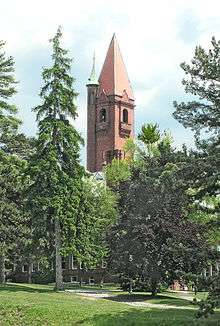Wells College
 | |
| Motto | Habere et dispertire (To have and to share) |
|---|---|
| Type | private coeducational liberal arts college |
| Established | 1868 |
| Endowment | $24,000,000 |
| President | Dr. Jonathan C. Gibralter |
| Provost | Dr. Cindy J. Speaker |
Academic staff | 69 |
Administrative staff | 120 |
| Students | 510 |
| Location | Aurora, New York, United States |
| Campus |
Rural 301 acres (1.22 km2) |
| Athletics | NCAA Division III—North Eastern Athletic Conference |
| Colors | red and white ]] |
| Nickname | The Express |
| Website |
www |
Wells College is a private coeducational liberal arts college in Aurora, Cayuga County, New York, on the eastern shore of Cayuga Lake. The college has cross-enrollment with Cornell University and Ithaca College, and is considered Cornell University's sister school. It is strengthening its off-campus study programs (most notably in Florence) and has created centers in sustainability, business and entrepreneurship, and book arts. Undergraduate students are required to participate in at least two off-campus internships during their time at Wells.
Wells College is located in the Finger Lakes region of New York. It is about an hour from Syracuse and Rochester and a half-hour drive from both Ithaca and Auburn. It is part of the Aurora Village–Wells College Historic District, listed on the National Register of Historic Places.
The college has five residence halls, seven academic buildings, and an average student body of 550. The student to faculty ratio is 9:1.
History

Wells was established as a women's college in 1868 by Henry Wells, founder of Wells Fargo and the American Express Company. Wells had the building for Wells Seminary constructed on property he donated. On August 9, 1888, the College's main building burned to the ground. The building was replaced in 1890 by the current Main Building, designed by architect William Henry Miller. Henry Wells' 1852 mansion, Glen Park, was purchased by the Alumnae Association in 1906 and given to the College for its use. It is now part of the campus as a residence hall for upper class women.
In 1965, Walter Netsch designed the Louis Jefferson Long Library. The design of this award-winning building inspired two other buildings on campus, Barler Music Hall and Campbell Art Building.
In 1886, Frances Folsom Cleveland Preston, Wells Class of 1885, became the youngest First Lady of the United States when she married Grover Cleveland. She was the first First Lady to be a college graduate and the only First Lady to be wed in the White House. She served on the College's Board of Trustees for 50 years and brought the College to national prominence.
Co-education
After 136 years as a women's college, Wells announced on October 2, 2004 that it would become a co-educational institution in 2005. This drew student protests on campus.[1][2][3] Some parents of students also became involved in the protests.[4] Some of the students said that their protests were patterned after ones at Mills College in the early 1990s.[5] A website called Wells for Women was established[6] After the college's decision to adopt coeducation was approved by its board, students filed a lawsuit, which the courts rejected.[7] The college adopted coeducation in 2005.
Academics
| University rankings | |
|---|---|
| National | |
| Forbes[8] | 544 |
| Liberal arts colleges | |
| U.S. News & World Report[9] | 168 |
| Washington Monthly[10] | 128 |
Classes at Wells are taught seminar-style by professors—not teaching assistants—and 83%[11] of Wells faculty have doctoral degrees.
The Washington Monthly's "College Rankings" (an alternative college guide to the U.S. News and World Report) ranked Wells College as No. 30 among all liberal arts colleges in the United States — as well as the top such college in New York state — in the September 2006 issue.[12]
In 2016, U.S. News ranked Wells at 174 (tied) among liberal arts colleges.[13]
Athletics
Athletics has been a key component of the Wells College experience for each student dating back to the institution's establishment in 1868. Traditions and rituals at Wells involving athletics are an important part of the collegiate experience for incoming students. The school's annual Odd/Even basketball game, annually drawing large crowds of current students and alumnae, was first played in 1898.
A member of the Private College Athletic Conference throughout the late 1970s and early 1980s, the Express captured four consecutive conference championships in tennis (1977–78, 1978–79, 1979–80, 1980–81) while also winning back-to-back titles in bowling (1978–79, 1979–80). Wells, who officially became an NCAA Division III institution prior to the 1986–87 athletic season, joined the Atlantic Women's Colleges Conference prior to the 1996–97 athletic season. In 1996, the Wells soccer team captured the school's only AWCC championship title.
As part of the Board of Trustees decision to begin accepting men to the traditionally all-women's college, Wells incorporated men's soccer, men's swimming and men's and women's cross country into their athletic cadre. Prior to 2005, the Express offered only six intercollegiate athletic sports: field hockey, softball, women's lacrosse, women's soccer, women's swimming and women's tennis.
Prior to the 2007–08 academic year, the Express were invited to join the North Eastern Athletic Conference and compete against 14 other schools in the East Region. In joining the NEAC, Wells was able to compete for conference championships with the added benefit of receiving an automatic qualifier in select sports to participate in the NCAA tournament.
Since joining the NEAC, Wells has captured six separate conference championships - men's swimming laid claim to the first league title in 2009–10 and earned their second title in 2012–13. Women's swimming have won conference championships during the 2011–12, 2012–13, and 2013–14 seasons. Men's basketball, who won the NEAC championship in 2010–11, was the first team from Wells to participate in the NCAA Tournament.
As of the 2015–16 athletic season, Wells offers 16 NCAA Division III varsity sports, including field hockey, men's and women's basketball, men's and women's lacrosse, men's and women's soccer, men's and women's swimming, men's and women's volleyball, men's and women's cross country, softball, baseball, and women's tennis.
Community involvement
- In September 2000, Wells held a festival, Return to Chonodote, honoring the area's Haudenosaunee past and present. The event was co-sponsored by SHARE, members of the Cayuga Nation and Onondaga Nation, and Ithaca College.
- Aurora Village-Wells College Historic District is considered a historic place.
Honor Code
Like a number of other liberal arts colleges, Wells has an honor code to which all students subscribe. By signing the Honor Code, Wells students pledge "not to lie, cheat, steal, deceive, or conceal in the conduct of their collegiate life".[14] Wells prides itself on its honor code, which permits it to maintain an environment where students are able to have take-home exams, and to work in their residence hall rooms, at the library, or on the dock by the lake, rather than in classrooms.
Points of interest
- The campus is located in the scenic town of Aurora; it is three miles north of Long Point State Park, and Cayuga Lake adds beauty to the scenery year-round.
- The docks provide a location to swim or just relax and enjoy the weather. Several events at Wells College are held here throughout the year. You may see the floating classroom docked here at various times throughout the year.
- The Wells College Golf Course is a publicly accessible nine-hole course that is free for Wells students to play on. Because of its location near the lake, this course is almost always thawed-out before any other courses in this region.
- The Waterfall is a short hike off of the golf course in the forests that surround campus. The region around the waterfall provides great views of the surrounding trees. In the fall the foliage changing colors provides a great location for photographers.
The String Room Gallery
The String Room Gallery is the main location for Art Exhibits. It is located on the first floor of Main Building and features exhibitions from local and international artists. This space is also the site of two student art shows per year, such as the Student Exhibition and the Senior Thesis Art Exhibit, which is organized and presented each May by graduating Visual Art majors.
Notable alumnae
- Frances Folsom Cleveland – First Lady of the United States and wife of President Grover Cleveland
- Pleasant Rowland – founder of Pleasant Company and creator of the American Girl brand of dolls, books, and accessories
- Laura Nader – Professor of Anthropology at the University of California, Berkeley.
- Kathleen M.L. West - journalist and activist
- Margaret Pericak-Vance – Professor of Human Genomics at the University of Miami Leonard M. Miller School of Medicine, best-known for identifying the Apolipoprotein E risk gene for Alzheimers.[15][16]
- Helen Barolini – Italian-American author of novels and essays
- Edith Kinney Gaylord – journalist, philanthropist, founder of Inasmuch Foundation and Ethics and Excellence in Journalism Foundation, and former president of the National Women's Press Club
- Margaret T. McFadden – Provost of Colby College
- Mary Beckerle – Ph.D and executive director of the Huntsman Cancer Institute. She is also a fellow of the American Academy of Arts and Sciences.
- Helen Tracy Lowe-Porter – translator of Thomas Mann's works
- Grace Carew Sheldon (1855–1921), American journalist, author, editor, businesswoman
- Helena Zachos – longtime faculty member at Cooper Union
Notable faculty past and present
- Jesse Bering – psychologist
- Robert P. T. Coffin – poet
- Frances "Sissy" Farenthold – politician and human rights activist, former Wells president
- John D. Graham – painter
- Victor Hammer – artist
- Paul Hindemith – composer and violinist
- R. Joseph Hoffmann – historian of religion, humanist activist
- J. J. Lankes – artist
- Lillian Rosanoff Lieber – mathematician and author
- Lewis H. Morgan – anthropologist
- Robert A. Plane – Wells president and chemist
- Thomas J. Preston, Jr. – Wells president pro temp (married Frances Cleveland, widow of Grover Cleveland)
- William Stokoe – English professor
- Margaret Floy Washburn – psychologist
Notes
- ↑ Tarby, Russ (2002-06-14). "Trustees greeted by angry students". AuburnPub.com. Retrieved 2011-08-13.
- ↑ Spohr, George (2002-06-14). "Students stage sit-in to protest". AuburnPub.com. Retrieved 2011-08-13.
- ↑ Barton, Noelle (2002-06-14). "Wells students not going home". AuburnPub.com. Retrieved 2011-08-13.
- ↑ Barton, Noelle (2002-06-14). "Angered Wells parents feel left out". AuburnPub.com. Retrieved 2011-08-13.
- ↑ Spohr, George (2002-06-14). "Wells students' sit-in patterned after Mills". AuburnPub.com. Retrieved 2011-08-13.
- ↑ "Wells for Women". Web.archive.org. 2009-10-27. Archived from the original on October 27, 2009. Retrieved 2011-08-13.
- ↑ Wogan, Lisa. "When Wells Run Dry: Another women's college opens the door to men". Ms. Magazine. Retrieved 2011-08-13.
- ↑ "America's Top Colleges". Forbes. July 5, 2016.
- ↑ "Best Colleges 2017: National Liberal Arts Colleges Rankings". U.S. News & World Report. September 12, 2016.
- ↑ "2016 Rankings - National Universities - Liberal Arts". Washington Monthly. Retrieved September 6, 2016.
- ↑ The Princeton Review
- ↑ The Washington Monthly College Rankings Archived 2014-11-07 at the Wayback Machine..
- ↑ "Wells College Rankings". U.S. News & World Report. Retrieved 2016-11-02.
- ↑ Wells Computer Services (2010-06-15). "Honor Code". Wells.edu. Retrieved 2011-08-13.
- ↑ "Margaret Pericak-Vance". Archived from the original on 2010-09-05. Retrieved 2008-03-26.
- ↑ Miami Institute for Human Genomics.